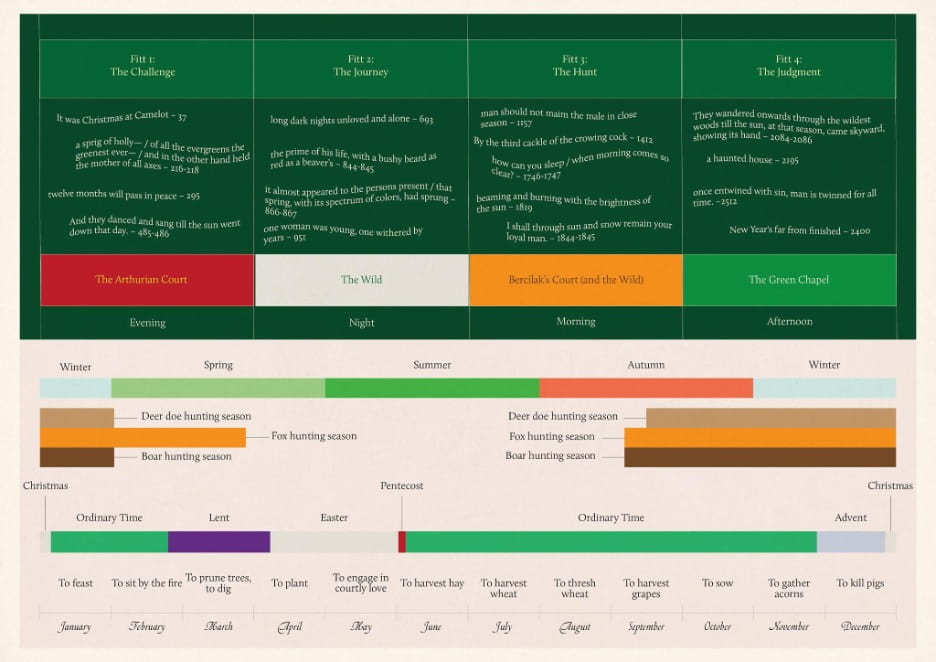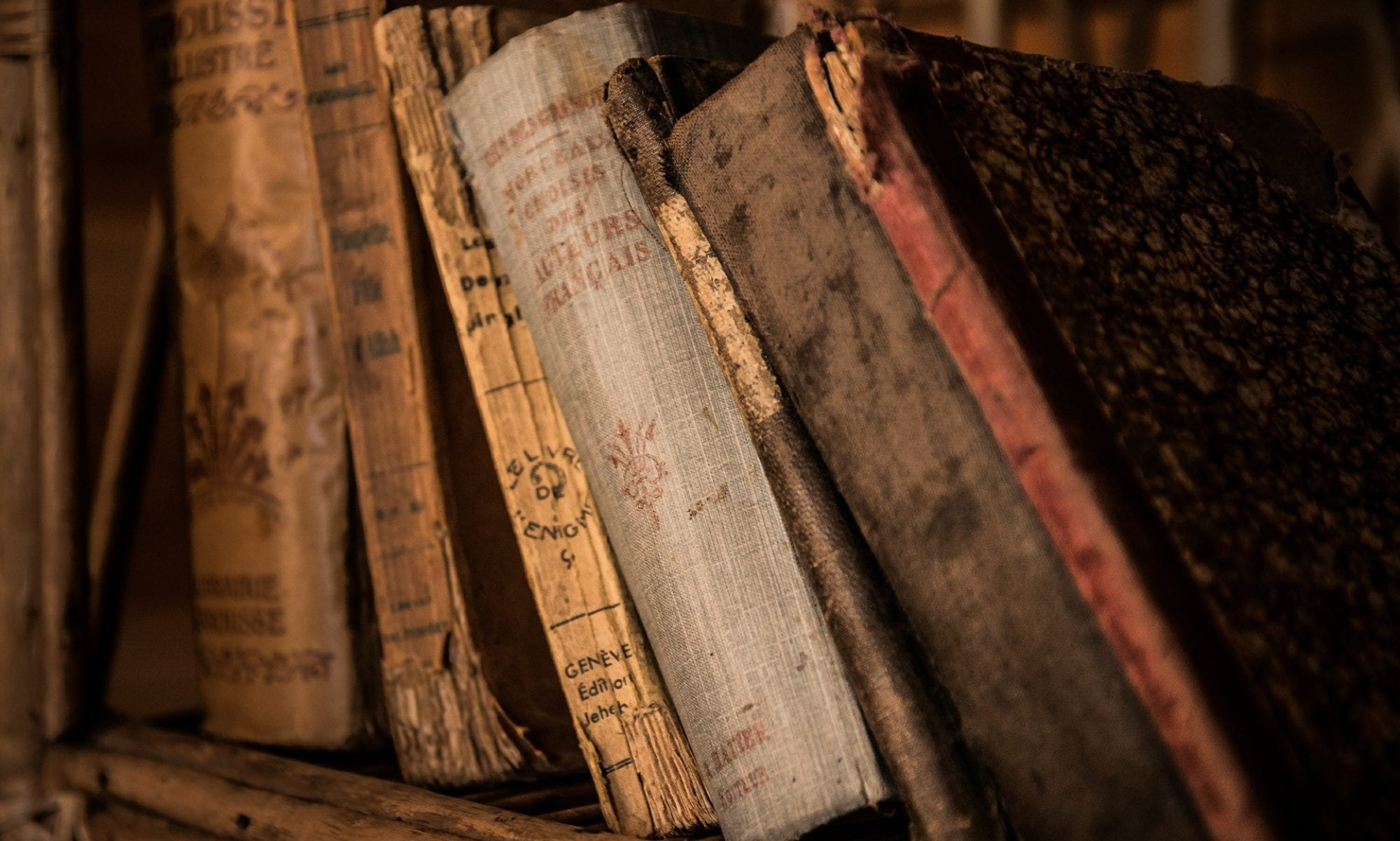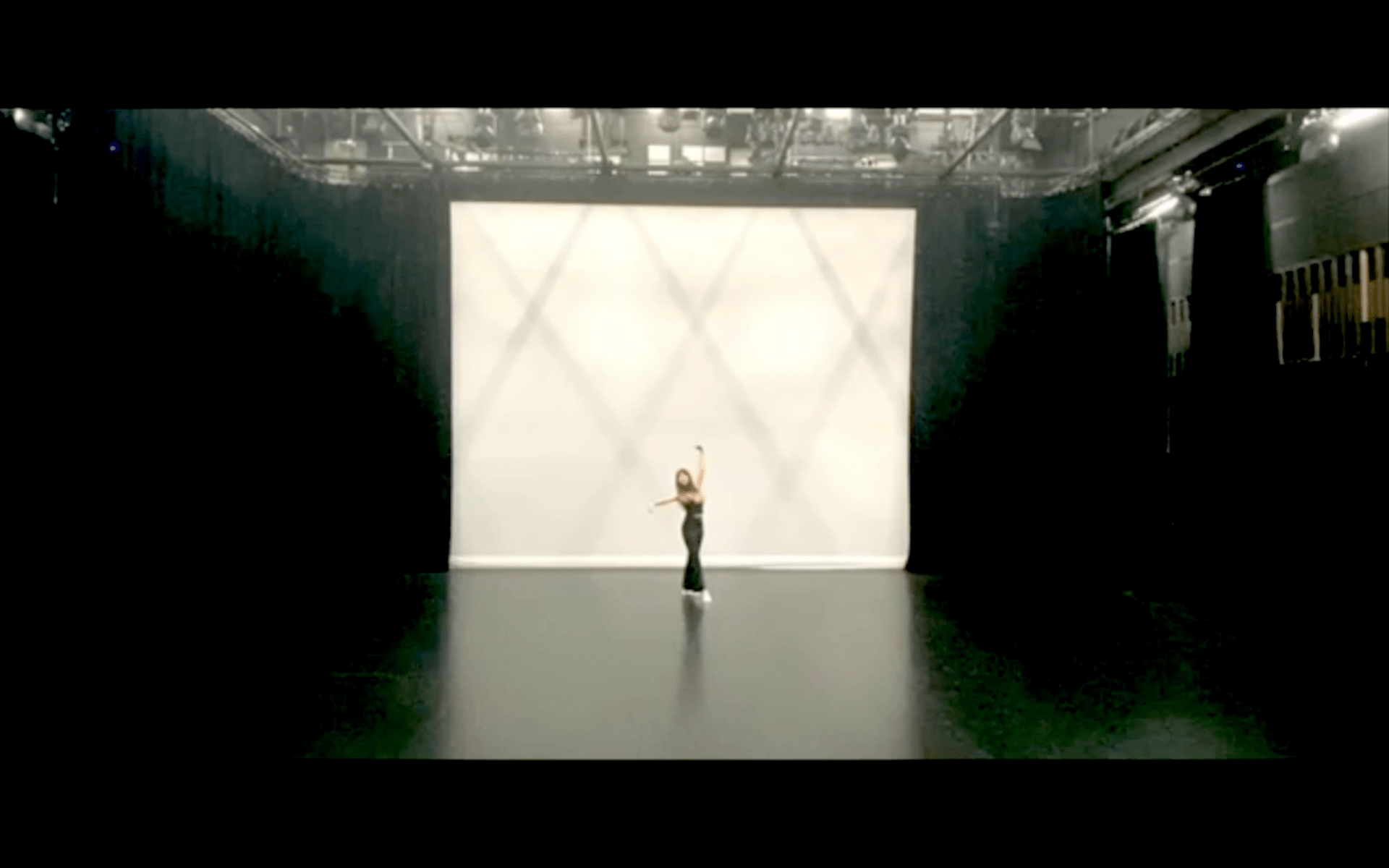CREATIVE PROJECT BY SUN WOO YOON (’23)
Creative Diagrams of Time in Sir Gawain and the Green Knight
Conceptual Diagram
An Interpretation of Sir Gawain and the Green Knight
Real and Imagined Animals in Medieval Literature (YHU2330)
2023

Artist’s Remarks
Reading Sir Gawain and the Green Knight, I was struck by the ways in which various formulations of time are layered on top of each other. While the entire narrative is set during the winter months, there is a sense that all the seasons of the year are contained within the four sections of the narrative. Related to this is the fact that the winter setting is highly symbolic, connoting a period before rebirth (the New Year appears as a frequent marker of Gawain’s mapping out of time in his head) that necessitates a death that can be understood as a kind of purging (after the Gawain’s repentance of his sins, the Green Knight announces, “I declare you purged” (Armitage, line 2393)). Here, I also draw upon Clark and Wasserman’s characterization of the poem as one that surrounds themes of apocalypse—Gawain here becomes a character who can redeem humanity through his virtue within a humanity that is increasingly descending toward immorality (Clark and Wasserman, 6). Yet, when set against various characterizations of time as cyclical (such as the Gawain-poet’s condensed overview of the changing of the seasons in Fitt 2), both ideas of apocalypse and seasonal change begin to enter the symbolic realm, opening up the possibility of understanding the way that various temporal changes hold meaning in relation to one another. From this, the overlapping temporalities in the poem: seasonal, historical, liturgical, as well as individual, begin to create tensions and unexpected parallels with one another.
This was particularly fascinating to me, because then the wintry setting of the poem can be interpreted as symbolic in itself, but also as one that can be set aside in favor of a characterization of the poem as representing the different seasons (and more broadly, different stages of the calendar year) within the couple of days during which the poem takes place. I do not think it is a coincidence that the poem is split into four sections, reflecting the four seasons, and the thematic elements of each section can be loosely attributed to the symbolic qualities of the seasons.
In order to do this, I characterized each Fitt by the major event that takes place in each: The Challenge in Fitt 1, The Journey in Fitt 2, The Hunt in Fitt 3, and The Judgment in Fitt 4. The clear narrative progression of the poem can be mapped onto various symbolic changes that come with time, such as seasonal changes. Taking a look at the Gawain-poet’s characterization of the seasons in Fitt 2, one can find particular resonances between the overarching themes that characterize the seasons with the events that take place in each Fitt. I see them as:
- Fitt 1 (The Challenge): Winter
- An end, death, feasting.
- Fitt 2 (The Journey): Spring
- Rebirth, a beginning.
- Fitt 3 (The Hunt): Summer
- Labor, leisure, and courtly love.
- Fitt 4 (The Judgment): Autumn
- Harvesting, reaping what one has sown.
These associations also draw from the tradition of formulating the calendar through the labor of the year—this genre of calendar typically called the Labours of the Months, where each month is associated with a particular activity. Laumonier offers more insight into the Labours of the Months:

“The winter months, starting with January, usually depicted indoor scenes (feasting, keeping warm by the fire, etc.). The fate of February depended on local weather. At the beginning of spring, work began outside to prepare the fields and trees. At the height of spring, usually in April and May, the calendar marked a pause to celebrate the rejuvenation of nature with scenes of leisure, love, and blooming flowers. From June to August, artists painted peasants hard at work, raking hay, reaping wheat, and threshing grain. In September, the scenery changed, the summer activities giving way to winemaking, usually followed by plowing and sowing. The last two months of the calendar year were devoted to fattening and killing boars and pigs, eaten during the feasting month of January. The cycle then started again undisturbed.” (Laumonier, n.p.)
However, it is important to note that the above ascriptions between the Fitts and the seasons are slippery—in some sense, one can find hints of each season in each Fitt (I initially started with ascribing Spring to Fitt 1, for example).
Another interesting way to associate the Fitts is through scaling time down to the meter of a single day. I found it intriguing that there are various moments within the poem where the Gawain-poet spends much time describing the time of day—dawns, dusks, and the movements of the sun figure into the atmospheric texture of the poem. Upon consideration, patterns within the Fitts emerge, such as the fact that Fitt 2 is characterized by the “long dark nights unloved and alone” (Armitage, line 693) that Gawain spends in the wilderness, while Fitt 3 is characterized by dawn/morning-time, given the lengthy scenes and descriptions of Bertilak awaking in the early morning to embark on his hunt while his wife wakes a still-asleep Gawain in order to spend time with him. Another set of associations is presented when looking through the lens of one day:
- Fitt 1 (The Challenge): Evening
- Fitt 2 (The Journey): Dusk
- Fitt 3 (The Hunt): Dawn
- Fitt 4 (The Judgment): Afternoon
Such temporalities are only further complicated by the additional presence of liturgical time in the poem, Christmas, All-Saints Day, and Lent marking time as well as divine symbolism to the events of the poem. When considering the connotations and the cosmological events that mark the liturgical calendar, other associations arise. Lent, the 40-day period of fasting and praying, for instance, can most clearly be associated with Fitt 2, where Gawain enters the icy wilderness and finds little to no food (an instance that could be understood as a representation of fasting). It is also fitting here that Gawain is only able to escape this period through the act of prayer—Bertilak’s castle only appears after Gawain prays for salvation from God.
- Fitt 1 (The Challenge): Christmas and the New Year
- Fitt 2 (The Journey): Lent
- Fitt 3 (The Hunt): Ordinary Time?
- Fitt 4 (The Judgment): Advent
Finally, other kinds of time that are presented as backdrops to the narrative can produce further resonances. Animal temporalities, for example, can be excavated in the poem. In Fitt 3, for example, Bertilak’s hunt contains an intriguingly ecological perspective of time and seasonal change in the hunting troop’s and Gawain’s recognition of hunting seasons—essentially placing the characters within an ecological net where the sustainable maintenance of animal populations appears in the narrative as an animal temporality which exists alongside the other modes of time presented in the poem.
Thus, for my creative project, I have attempted to place the various temporalities in the poem alongside one another, creating a kind of mapping where the representations of time in and of the narrative can be viewed clearly in relation to one another. I chose to represent time through diagrams that combine logical and rational progressions of time with creative representations to keep with the Gawain-poet’s preoccupation with mathematics and geometry in the poem, presenting a matrix of understanding time in the poem that could accompany its reading and offer points of discovery for readers.
Two diagrams were created: a diagram of various types of seasons and years that can be found in the poem, and a quadrisected timeline of the poem itself. My hope is that the timelines be considered alongside the poem and subsequently annotated and built upon by readers, so as to create an ever-growing instantiation of time in this mysterious and elusive poem.
REFERENCES
Armitage, Simon. Sir Gawain and the Green Knight. W.W. Norton, 2008.
Calkins, Robert G. Illuminated Books of the Middle Ages, mp 246, Ithaca, New York: Cornell University Press, 1983
Clark, S. L., and Julian N. Wasserman. “The Passing of the Seasons and the Apocalyptic in ‘Sir Gawain and the Green Knight.’” South Central Review, vol. 3, no. 1, 1986, pp. 5–22. JSTOR, https://doi.org/10.2307/3189122. Accessed 1 May 2023.
Laumonier, Lucie. “Medieval Calendars and the Labours of the Months.” Medievalists.net, 16 July 2022, www.medievalists.net/2022/07/medieval-calendars-labours-months/. Accessed 30 Apr. 2023.
Mclean, Will. “A Commonplace Book: Medieval Hunting Seasons.” A Commonplace Book, 4 Sept. 2015, willscommonplacebook.blogspot.com/2015/09/medieval-hunting-seasons.html. Accessed 30 Apr. 2023.
Wikipedia Contributors. “Liturgical Year.” Wikipedia, Wikimedia Foundation, 23 Oct. 2019, en.wikipedia.org/wiki/Liturgical_year.






















